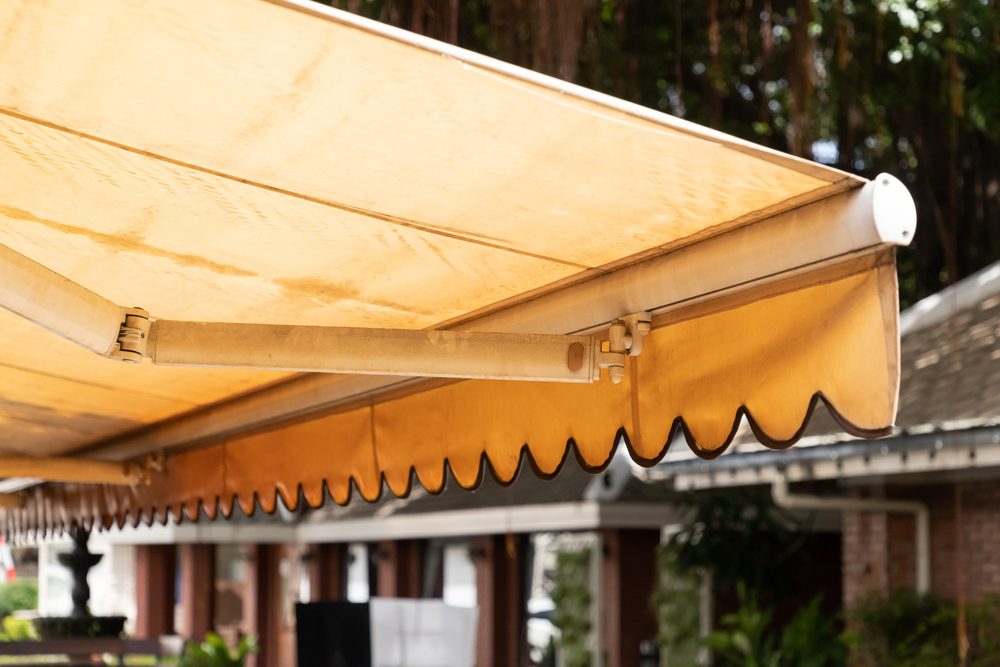Physical Address
304 North Cardinal St.
Dorchester Center, MA 02124
To clean canvas awnings, mix mild soap with warm water and scrub using a soft brush. Rinse well with water.
Canvas awnings can accumulate dirt, grime, and mildew over time due to exposure to the elements. Proper cleaning not only maintains the appearance but also prolongs the lifespan of the awnings. By following the simple steps outlined for cleaning canvas awnings, you can keep them looking fresh and new.
Additionally, regular cleaning will prevent mold and mildew growth, ensuring a clean and appealing outdoor space for your home or business. Remember, proper maintenance is essential for preserving the beauty and functionality of your canvas awnings.
Canvas awnings are a popular choice for providing shade and protection from the elements. They are versatile, durable, and can enhance the aesthetic appeal of any outdoor space. To ensure that your canvas awnings stay in top condition, it’s essential to understand the different types and materials used in their construction.
Retractable Awnings: Easily adjustable to suit changing weather conditions, providing flexibility and convenience.
Canvas Fabric: Durable and weather-resistant, ideal for outdoor use due to its strength and longevity.
Before you begin the task of cleaning your canvas awnings, you’ll need to gather the following tools and materials to ensure the process goes smoothly and effectively.
A soft bristle brush is essential for gently removing dirt and debris without damaging the delicate canvas material of your awnings.
Using a mild cleaning solution will help to effectively clean the canvas awnings without causing any discoloration or damage to the fabric.
Having a ladder or scaffold on hand will allow you to safely reach and clean all areas of your canvas awnings, ensuring a thorough cleaning process.
As you prepare to clean your canvas awning, it’s essential to begin with thorough preparation. Proper preparation ensures that the cleaning process is effective and safe for your awning. This involves inspecting for damage, clearing debris and dirt, and gathering the necessary cleaning supplies.
Before starting the cleaning process, inspect the canvas awning for any signs of damage. Look for tears, rips, or mildew spots that may need special attention. This inspection will help you determine the best approach for cleaning and address any maintenance needs.
Clearing debris and dirt is an essential step in preparing your canvas awning for cleaning. First, remove any loose leaves, twigs, or other debris that may have accumulated on the surface. Using a soft-bristled brush, gently sweep away dirt and dust from the awning fabric. This ensures that the cleaning solution can effectively penetrate the material and remove stains more thoroughly.

Credit: www.vevor.com
Canvas awnings provide shade and protection to your outdoor space, but they can also accumulate dirt, stains, and debris over time. To keep your canvas awnings looking their best, regular cleaning is essential. In this blog post, we will discuss effective cleaning techniques to help you maintain the appearance and longevity of your canvas awnings.
Stains on your canvas awnings can be unsightly and diminish their overall appearance. Spot-treating stains promptly will prevent them from becoming ingrained and more difficult to remove. Here’s how you can effectively spot-treat stains:
Regular brush cleaning is a simple yet effective way to maintain the cleanliness of your canvas awnings. Brush cleaning eliminates dust, dirt, and debris from the surface and helps prevent mold and mildew growth. Follow these steps for gentle brush cleaning:
Rinsing and drying your canvas awnings after cleaning is crucial to prevent mold, mildew, and water damage. Follow these steps to ensure proper rinsing and drying:
By following these cleaning techniques, you can effectively remove stains, dirt, and debris from your canvas awnings, ensuring they remain looking their best for years to come.
Canvas awnings are not only decorative but also provide shade and protection from the elements. However, over time, these awnings can develop mold and mildew, which not only look unsightly but can also cause health issues. In this section, we will discuss how to identify mold and mildew on canvas awnings and the steps to effectively remove them using a vinegar solution. Read on to learn more!
One of the first steps in tackling mold and mildew on canvas awnings is to accurately identify them. Mold and mildew are similar in appearance but have slightly different characteristics. Mold is usually fuzzy, greenish-black, or brown in color, while mildew appears as powdery white substance. Keep an eye out for discolored patches and a musty odor, as these are clear indications of mold and mildew growth on your canvas awnings.
When it comes to removing mold and mildew from canvas awnings, a simple and effective solution is vinegar. Vinegar is a natural cleaner that is non-toxic and safe to use. To create a vinegar solution, mix equal parts of white vinegar and water in a spray bottle. Spray the solution onto the affected areas of the awning, ensuring complete coverage. Let the solution sit for 30 minutes to an hour to allow the vinegar to penetrate the mold and mildew.
After the waiting period, use a soft-bristled brush or sponge to gently scrub the affected areas. Make sure to apply moderate pressure to avoid damaging the canvas. As you scrub, you will notice the mold and mildew loosening. Rinse the awning thoroughly with clean water to remove any remaining residue. For stubborn mold and mildew stains, repeat the process until the stains are completely gone.
TIP: For an extra boost of cleaning power, you can add a few drops of dish soap to the vinegar solution. This will enhance its ability to break down the mold and mildew, making the removal process even more effective.
Once you have successfully removed the mold and mildew from your canvas awnings, allow them to air dry thoroughly before retracting or rolling them up. This will prevent any moisture from getting trapped and causing further mold and mildew growth. By following these simple steps, you can keep your canvas awnings looking fresh and mold-free for years to come!

Credit: fj-outdoors.com
When it comes to maintaining your canvas awnings, regular inspection and applying protective coatings are essential for ensuring their longevity and appearance. By following the right maintenance tips, you can keep your canvas awnings in top condition and prolong their lifespan. Here are some crucial maintenance tips to help you properly care for your canvas awnings.
Regularly inspect your canvas awnings to identify any signs of wear and tear. Look for rips, tears, or mold growth, and address any issues promptly to prevent further damage. Check the framework for stability and ensure that all hardware is functioning properly. Regular inspection allows you to catch potential problems early and prevent costly repairs down the line.
Apply protective coatings to your canvas awnings to safeguard them from environmental elements such as UV rays, moisture, and dirt. Consider using a specialized fabric protector to create a water-repellent barrier and prevent mold and mildew growth. Additionally, applying UV-resistant coatings can help prevent color fading caused by sun exposure. Regularly reapplying protective coatings can help maintain the quality and appearance of your canvas awnings over time.

Credit: rollac.com
Regular cleaning and maintenance are essential for keeping your canvas awnings in top condition. By following the simple tips and techniques outlined in this blog post, you can ensure that your canvas awnings remain looking great and last for years to come.
Remember to use gentle cleaning solutions and avoid harsh chemicals to protect the fabric’s integrity. With a little care and attention, your canvas awnings will continue to enhance the appearance of your outdoor space.